Trails Essay – May 2024
by Matthew Cleary
 I make hiking trails for a living. It is the best job in the whole world. We are not volunteers. We take our work very seriously. To build a hiking trail that lasts, that is safe, that encourages people to remain on the path and minimizes the damage our presence can cause on the sensitive ecosystems through which we pass, is long, often grueling work, but it is also one of the most rewarding and meaningful endeavors I can imagine doing.
I make hiking trails for a living. It is the best job in the whole world. We are not volunteers. We take our work very seriously. To build a hiking trail that lasts, that is safe, that encourages people to remain on the path and minimizes the damage our presence can cause on the sensitive ecosystems through which we pass, is long, often grueling work, but it is also one of the most rewarding and meaningful endeavors I can imagine doing.
We all know the benefits of hiking trails, the effect spending time in nature can have on our physical and mental health, on our connectedness to nature, on our willingness to conserve and educate ourselves about the ecosystems that surround us. To be tasked with the job of making the forest accessible to visitors of diverse capacities and levels of experience is a responsibility we do not take lightly.
In this essay I intend to describe our process a bit, to explain the motivations behind the practical choices we make and the steps we take in the work we perform. We are, at times, land surveyors and lumberjacks, pack mules and stone masons, carpenters, gardeners, and landscapers. In the end, the trail must look like it emerged from the earth intact and whole, as if it had to be where it is and could not have been anywhere else. It takes a great deal of planning and work. By the time the trail finally opens after months or years of blisters, sore backs, and ticks, we know every meter by heart, every turn, interesting rock, and grandmother tree.
Once opened, a trail continues to evolve. It is rare that outside materials are introduced. Our building materials are typically found on site or nearby, and in building the trail, we have only changed the arrangement of the things we found in the forest, the soil, rocks, and wood. Once the trail is made, the plants and trees continue to grow. The earth continues to freeze and thaw with the seasons. The surrounding nature assimilates the trail in its new form. Ideally, the soil we have moved stabilizes, the roots we have disturbed heal, and the animals return or come out of hiding.
I have been building hiking trails for the Massawippi Conservation Trust since the beginning. The creation of the Trust and its conservation and environmental education work ever since has been the result of countless wonderful people, and the list continues to grow. The land that has been spared from development and made accessible to the public through the network of hiking trails continues to be a gift to the community, now and for generations to come. I am honored to be involved, and lucky to have spent more time than anyone else in the world on the trails I have had so much fun building.
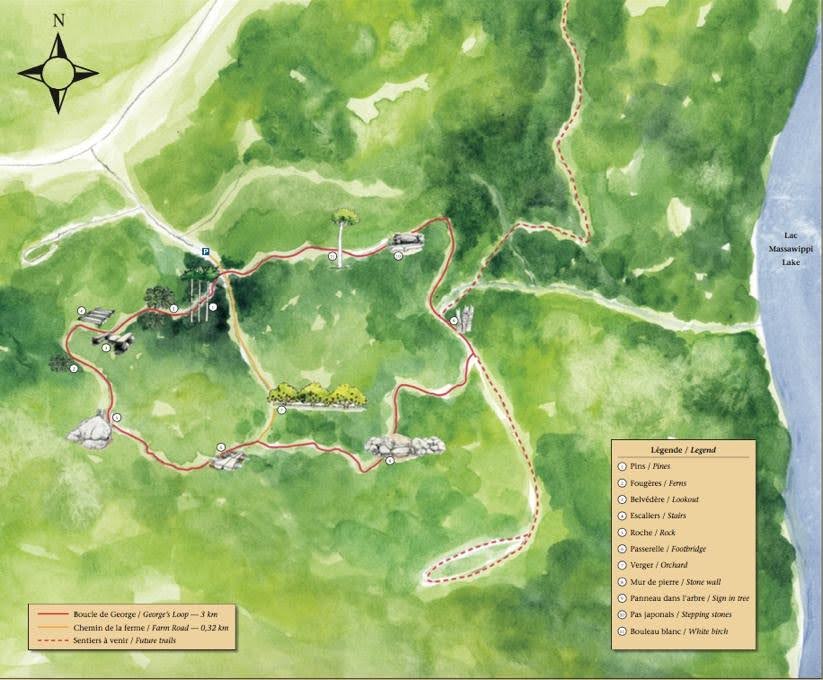 To describe our process more specifically, and anecdotally I suppose, I will tell the story from my perspective of the conceptualization and construction of George’s Loop. This was the first trail to open in the Wardman Sector of the Massawippi Trail. I have included maps, of the trail network then and now, to give an idea of our progress. The map will continue to grow. For those building these trails, the map serves as a diary. It is hard to look at it and not remember the stories associated with it. Here we began, at this turn. There is where we were when the leaves changed. That switchback was when Mahicans had his baby. Here it began to snow and we all stopped working at the same time and looked up to watch it fall.
To describe our process more specifically, and anecdotally I suppose, I will tell the story from my perspective of the conceptualization and construction of George’s Loop. This was the first trail to open in the Wardman Sector of the Massawippi Trail. I have included maps, of the trail network then and now, to give an idea of our progress. The map will continue to grow. For those building these trails, the map serves as a diary. It is hard to look at it and not remember the stories associated with it. Here we began, at this turn. There is where we were when the leaves changed. That switchback was when Mahicans had his baby. Here it began to snow and we all stopped working at the same time and looked up to watch it fall.
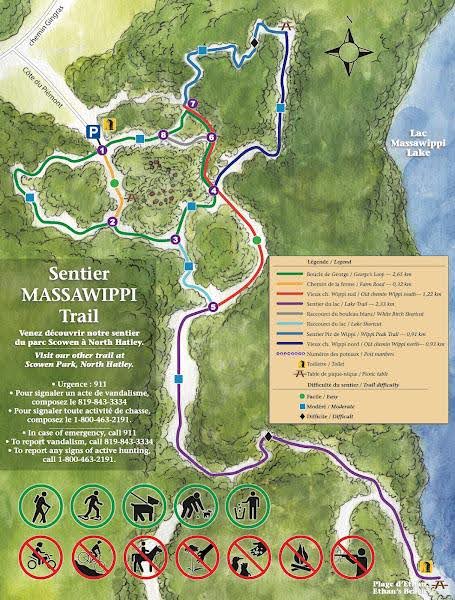 The first time I explored the forest the Wardman family had so generously donated to the Trust, I was with Mahicans Diamond, our fearless leader and trail consultant. I had fished in Lake Massawippi for years, but I had never really explored the forest covering the mountains on the west side of the lake. My first impression, not having seen its limits, was that the forest was vast and wild. I even carried my bear spray. In the first week, I saw the same fox several times and a porcupine in a tree waiting as we passed below. We also came across a few dear stands, a popular salt block, and the remnants of a truck from the 1940s in a ravine.
The first time I explored the forest the Wardman family had so generously donated to the Trust, I was with Mahicans Diamond, our fearless leader and trail consultant. I had fished in Lake Massawippi for years, but I had never really explored the forest covering the mountains on the west side of the lake. My first impression, not having seen its limits, was that the forest was vast and wild. I even carried my bear spray. In the first week, I saw the same fox several times and a porcupine in a tree waiting as we passed below. We also came across a few dear stands, a popular salt block, and the remnants of a truck from the 1940s in a ravine.
We parked at the end of Côte du Piémont where a large pile of gravel blocked the way on to where a farm used to be. The neighbors on both sides of the dead end were skeptical, and wondered aloud why would anyone in the world come here in the middle of nowhere to walk in the woods. It was not a virgin forest. There were a couple of old logging roads and four-wheeler tracks, and even a cross-country ski trail passed through that once linked North Hatley to Ayer’s Cliff before development and private property carried the day. An advertisement for the experience is included below. I suspect the prices are no longer valid.
 In the case of George’s Loop, we had no Point A from which to start on our trek toward Point B. The mandate was simply to make the forest accessible to visitors of all comfort levels in the woods. There are many ways to build a hiking trail, with varying degrees of intervention, from a raised, wide path of stone dust with ditches on both sides and culverts allowing water to pass from one side to the other wherever necessary to prevent trail erosion. The other extreme involves simply clearing obstacles on the surface and walking on the forest floor as is. The first extreme is costly and limits the degree to which hikers feel part of nature when they hike. The second extreme quickly disappears if not used enough, and if used too much becomes a path of muck. The trail is beaten down by walkers as the network of capillary roots giving structure to the ground breaks down. Hikers avoid the lowest, wettest part of the trail in the center and the trail gets wider and wider as the process continues.
In the case of George’s Loop, we had no Point A from which to start on our trek toward Point B. The mandate was simply to make the forest accessible to visitors of all comfort levels in the woods. There are many ways to build a hiking trail, with varying degrees of intervention, from a raised, wide path of stone dust with ditches on both sides and culverts allowing water to pass from one side to the other wherever necessary to prevent trail erosion. The other extreme involves simply clearing obstacles on the surface and walking on the forest floor as is. The first extreme is costly and limits the degree to which hikers feel part of nature when they hike. The second extreme quickly disappears if not used enough, and if used too much becomes a path of muck. The trail is beaten down by walkers as the network of capillary roots giving structure to the ground breaks down. Hikers avoid the lowest, wettest part of the trail in the center and the trail gets wider and wider as the process continues.
The most important decisions involved in building a trail occur at the beginning. I find it helps to explore an area in the spring when leaves do not obstruct the view of the contours of the terrain. To maintain a trail that hikers will choose to follow, trail erosion is our biggest concern. I try to imagine myself as a drop of water from rain or melted snow. Where would I go? Where would I stagnate? Building a trail is expensive. We have to imagine the absolute biggest rainstorm and flood that might happen in the next 20 years and prepare our trails against it if we want the trail to last 20 years. This is a bigger and bigger challenge as our weather has become more unpredictable and extreme.
After wandering the woods, getting a feel for what’s there, how humid it is, what sights and unique micro-ecosystems hikers might appreciate walking through, we begin to identify the trail corridor. This is an area about five meters wide where the trail will be built. If it is too steep, we plan to build stairs. If it is too humid, we plan to raise the walking surface somehow. The first pass is with a chainsaw. The hazardous trees are cut and the obstacles removed. If anything that is cut or found on the ground is large enough to use to build structures, trees or rocks, we leave it whole nearby and plan where and how we might use it.
The beginning of George’s Loop was easy. The trail gradually climbed as it passed through a plantation of widely spaced pine trees and the soil was relatively dry. Our trails are made with hard packed mineral soil. Vegetation has a harder time growing, and once the trail is compact, it is very durable and resistant to erosion if it is shaped correctly. We remove the organic layer of soil and bury it next to the trail in big pits we dig in search of deeper mineral soil. This is done with shovels or a machine.
The trail must be crowned, higher in the center, to withstand the further compaction from hikers and weather and to avoid accumulating water. Ideally we find ridges on which to build the trail. Disturbed soil erodes much faster than soil with rooted vegetation and leaf litter, so the less contact our trail has with water the better. Even on flat terrain a trail must undulate in waves to avoid accumulating water, and the trough of each wave must have an outlet where water can run off the trail.
We are meticulous in renaturalizing an area once we finish a section of trail. Disturbed soil erodes much faster than soil with rooted vegetation and leaf litter. We plant ferns. We spread leaves. We aspire to leave the forest as pristine as we found it.
Past the pine stand and an area covered by mature maples and ferns, we arrived at our first summit. We built two benches out of a nearby maple that had fallen and managed to roll a rock up the hill the top to serve as a table. As a team we pry and roll our rocks with heavy iron bars we use as levers. Sisyphus would be proud. Sometimes we use ropes and pullies to help fall trees or move rocks. These simple machines are often all we have access to and all we need.
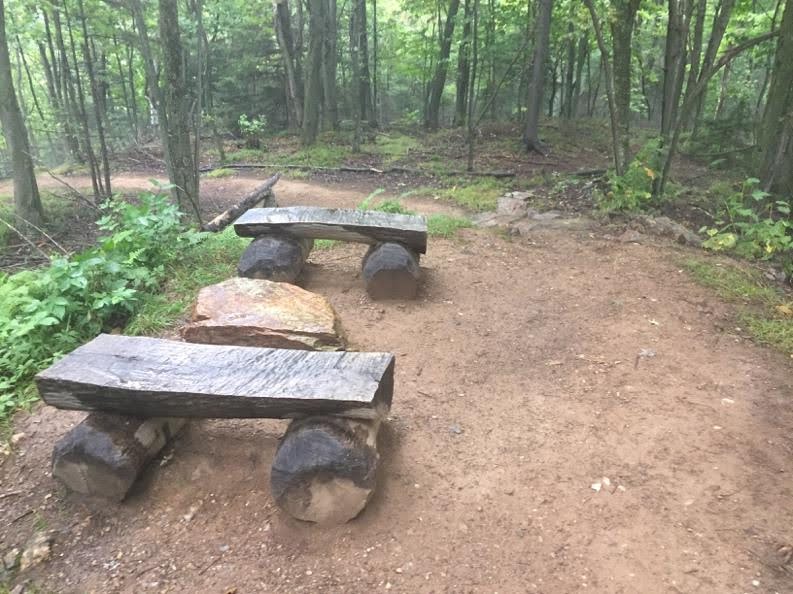
The descent from the first summit is a bit too steep for switchbacks alone to lessen the grade. We built terraced steps out of logs. We remove the bark with a hammer and cut a flat surface on each log. Removing the bark allows the log to dry and slows its decomposition. Each step is bordered by rocks to retain the mineral soil we fill inside.
Sometimes the steps are made from large stones we find nearby. We use whatever is available and practical. Whenever we encounter a humid area we must cross, we canalize the crossing water between two large stones to allow hikers to step from one side to the other without muddying the water or their boots.
George’s Loop returns close to the site of a farm where there remains the stone foundation of the farmhouse with trees growing where the house once stood and a small clearing surrounded by apple trees. We found some abandoned tractor parts and horseshoes. I have heard the area used to be a sheep farm, but I cannot confirm it.
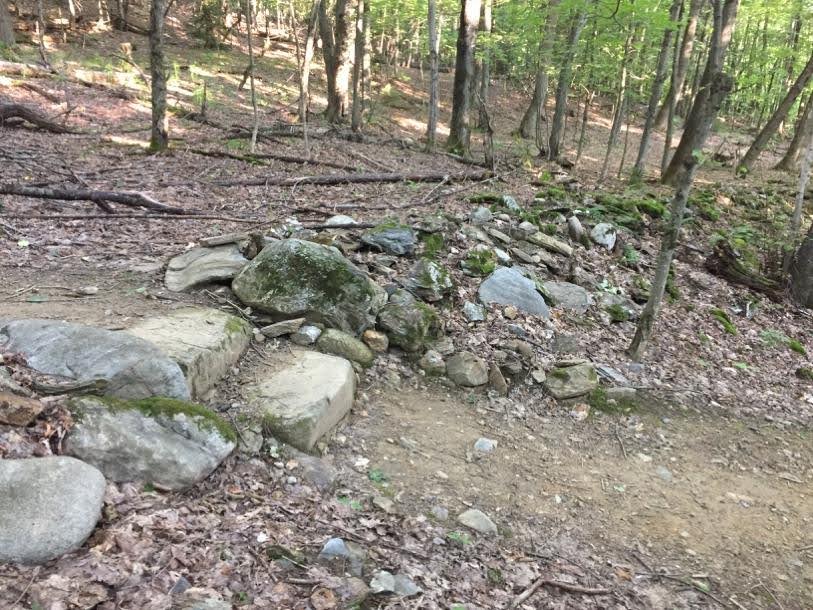 The trail continues down toward what used to be the Skiwippi trail, cutting through a straight, long pile of stones that once served as a fence or property line.
The trail continues down toward what used to be the Skiwippi trail, cutting through a straight, long pile of stones that once served as a fence or property line.
The section of George’s Loop along the Skiwippi trail is wide and flat, with ditches and culverts. In building the trail we found a metal wagon wheel. We left it in view leaning against a tree for hikers to marvel at as they passed. It wasn’t long before it disappeared. It is, no doubt, adorning someone’s garden now. There are other remnants of this path’s multiuse history. There is a kilometer marker being slowly swallowed by a tree, and it is on this trail that the rusty skeleton of a truck can be found.
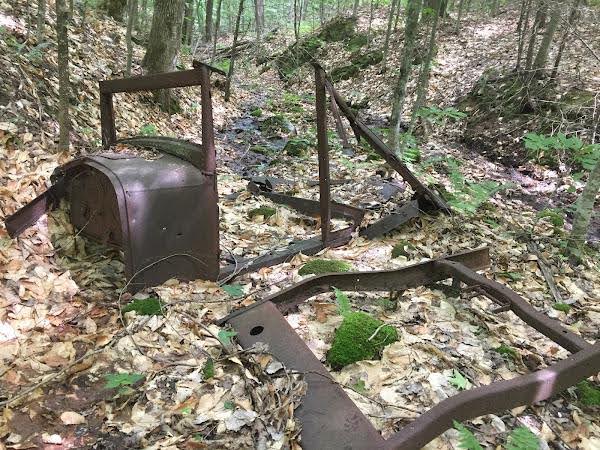 It took us over a year to build George’s Loop. It takes about 45 minutes to walk it completely. Hiking gives a person a chance to think and reflect and decompress without the distraction of other people, without constant contact and the demands of our electronic devices. In other moments it allows us to be completely present with those friends and family around us. The land here has had many uses over the years, dating back thousands of years, but whatever it has meant for people living nearby, its importance as a store of carbon and a home for plants and animals remains. We must remember that we are guests in the forest, and strive to act as its protectors as best we can.
It took us over a year to build George’s Loop. It takes about 45 minutes to walk it completely. Hiking gives a person a chance to think and reflect and decompress without the distraction of other people, without constant contact and the demands of our electronic devices. In other moments it allows us to be completely present with those friends and family around us. The land here has had many uses over the years, dating back thousands of years, but whatever it has meant for people living nearby, its importance as a store of carbon and a home for plants and animals remains. We must remember that we are guests in the forest, and strive to act as its protectors as best we can.

